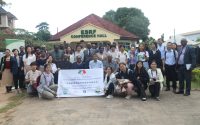Opinion: A Pivotal Step Towards Prosperity – The EAGC-USAID Partnership
By Neema Munisi
The recent announcement of the partnership between the Eastern Africa Grain Council (EAGC) and the United States Agency for International Development (USAID), under its Economic Recovery and Reform Activity (ERRA) program, is not just a news event – it’s a beacon of hope and a testament to the potential of strategic alliances in transforming the agricultural landscape of East Africa.
The collaboration, a substantial investment of US$2 million over three years, is a significant commitment towards enhancing the export-oriented staple food value chains in East Africa. This initiative is a critical step in acknowledging and addressing the myriad challenges that have long stifled the agricultural potential of this region. For decades, East African farmers and grain traders have battled with issues like low production rates, poor post-harvest management, and the daunting effects of climate change. These challenges have not only affected the competitiveness of their produce in regional and global markets but have also had far-reaching implications on food security and economic stability in the region.
The ERRA program, powered by a US$75 million budget over five years, demonstrates a focused intent to drive transformative trade and investment reforms. What makes this program unique and commendable is its inclusive approach. By prioritizing the creation of job opportunities in staple crops and textiles sectors, especially for women and youth, the program is addressing the core socio-economic segments that are pivotal for sustainable development.
The strategic collaboration with the EAGC, an organization that has been the leading voice of the grain industry in Africa, is particularly noteworthy. This partnership is a clear indication of the growing recognition of the importance of regional organizations in driving development agendas. The EAGC’s mandate to facilitate efficient, structured, inclusive, sustainable, and profitable grain trade aligns perfectly with the objectives of the ERRA program, making this partnership a harmonious and powerful alliance.
The introduction of innovative strategies like Grain Business Hubs (G-Hubs) is a game-changer. These hubs, operated by farmers and leveraging technology, are set to revolutionize the way grain quality is managed and trade is conducted. This approach not only empowers local farmers but also ensures that the benefits of technological advancements are accessible at the grassroots level. It is an approach that promises to transform traditional farming into a more dynamic, competitive, and profitable venture.
Moreover, the focus on compliance with international standards, particularly Sanitary and Phytosanitary (SPS) measures and Standards Quality Infrastructure (SQI) requirements, is crucial. This aspect of the partnership addresses one of the major impediments to grain trading in the region – the challenge of meeting global quality and safety standards. By supporting over 80 SMEs to successfully meet these standards, the EAGC-USAID partnership is not just opening doors for these businesses to access new markets but is also enhancing the overall quality and safety of the food supply chain.
The vision expressed by EAGC Executive Director Gerald Masila, emphasizing practical, impactful solutions, is inspiring. The focus on fortifying grain business hubs, enhancing SME capacities, and establishing an information hub for informed decision-making is a holistic approach that promises to address the various facets of the grain trade ecosystem. This approach reflects a deep understanding of the sector’s needs and a commitment to addressing them in a comprehensive manner.
What is particularly commendable about this initiative is its potential to catalyze food security and reinforce East Africa’s strategic position in international trade. Food security is not just about ensuring a sufficient supply of food; it’s about ensuring access to nutritious and affordable food. By enhancing the efficiency and profitability of grain trade, this partnership directly contributes to improving the quality of life for millions of people in the region.
Furthermore, this partnership is a testament to the power of international collaboration in addressing global challenges. The role of the United States government, through USAID and TMA, in facilitating this initiative highlights the importance of developed countries supporting developing regions in their quest for economic and social development. It’s a model of development cooperation that, if replicated, could have significant positive impacts on global efforts to reduce poverty and promote sustainable development.
The partnership between EAGC and USAID is a pivotal step towards prosperity for East Africa. It’s an initiative that not only promises to transform the agricultural sector but also has the potential to impact the lives of millions in the region positively. By addressing key challenges, leveraging technology, and focusing on inclusive growth, this partnership is setting a precedent for how strategic alliances can effectively contribute to regional development. It’s an inspiring model of collaboration, innovation, and commitment towards a common goal of prosperity and sustainability.


